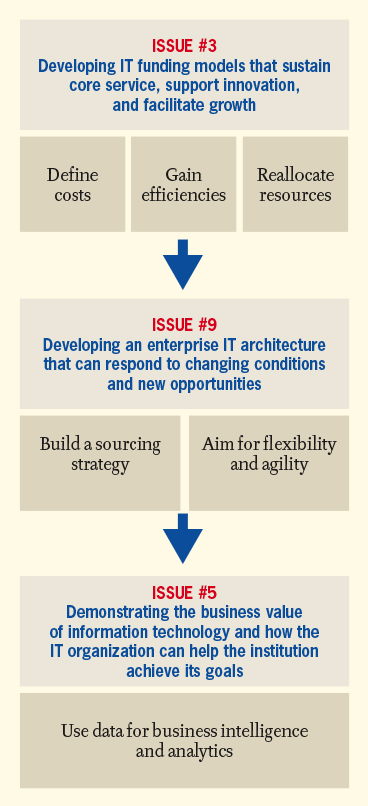Betsy Tippens Reinitz is Director of Administrative IT Programs, EDUCAUSE.
Visit the EDUCAUSE top 10 IT issues web page for additional resources, including a video summary, interactive graphics, recommended readings, and more.
Three of the EDUCAUSE Top 10 IT Issues for 2015 offer a useful lens for viewing administrative IT programs at higher education institutions. Taken together, these three issues can serve as a roadmap for administrative IT strategy:
- First, determine the costs of administrative services and, using that information, work to gain efficiencies in the delivery of those services, potentially freeing up resources that can be reallocated to areas that enable growth and innovation (Issue #3).
- Next, prepare for the future by developing an effective sourcing strategy that promotes flexibility and agility (Issue #9).
- Finally, demonstrate the business value of administrative information technology by using its data for business intelligence and analytics initiatives in support of the institutional mission (Issue #5).

Issue #3: Developing IT Funding Models That Sustain Core Service, Support Innovation, and Facilitate Growth
Understanding the full costs of providing administrative IT services is a necessary first step in developing this kind of funding model. But these costs are difficult to calculate. They are a combination of one-time and ongoing costs, and they use both capital and operating funds. They involve staff resources, software licenses, hardware expenses, and long- and short-term contracts. They also include hidden costs such as energy and facility expenses. Although understanding these costs is essential, calculating these costs can be an overwhelming task. If resources for this costing work are limited, IT leaders can still make progress by getting an approximation of costs as a starting point.
Once costs are better understood, IT leaders should look for ways to be more efficient, keeping in mind that most administrative IT services, though essential to operations, do not significantly differentiate one institution from another. Many administrative systems are heavily customized in ways that may contribute to the cost of the service without adding value. IT leaders should work with functional units to gain efficiencies through standardization and redesign of business processes in order to decrease customizations and align processes. The resulting reduced or avoided costs may allow for the reallocation of resources from a focus on the operation of the institution to a focus on its growth or transformation.
IT leaders should also consider looking outside their organizations for innovation opportunities. For example, decentralized IT units may be able to foster growth and innovation in ways not possible within the central IT organization.
Issue #9: Developing an Enterprise IT Architecture That Can Respond to Changing Conditions and New Opportunities
IT leaders need to be ready for potentially big changes in how they architect and deliver administrative IT services. With the growth of cloud services, an enterprise architecture that follows one primary system or suite is becoming less practical, while the integration of architecture and data from multiple systems is becoming more common.
As the IT focus shifts away from the delivery of technology to the delivery of services, IT leaders need to consider the importance of flexibility for future data integration. And as more administrative services are moved to hosted solutions, institutional leaders need to develop strategies for data flow between campus-hosted and off-site systems. Staff skill sets may also need to evolve as data integration and contract management become more important.
To set direction, IT leaders should develop criteria for decision making about the hosting and managing of administrative services. It is important to think of the services themselves as the focus of the decision, rather than the technology used to provide the services. Decision criteria will vary depending on campus culture, available resources, and long-term goals but may include issues related to the recovery and retention of data, the management of institutional risk, and the ability to conform to applicable regulations and laws. Many institutions are considering a cloud-first strategy, in which a cloud solution is favored whenever feasible. Cloud solutions can offer scalability and flexibility not available through on-premise hosting, as well as faster deployments and upgrades.
Issue #5: Demonstrating the Business Value of Information Technology and How the IT Organization Can Help the Institution Achieve Its Goals
Although the operational aspects of administrative IT systems are critical to institutional goals, the business value of information technology can be demonstrated most clearly through the use of analytics and business intelligence.
Administrative data serves as an important institutional asset, but the strategic value of administrative information technology is sometimes under-realized. IT leaders need to educate their institutions about the importance of data in furthering institutional goals, and they need to play a leadership role in developing an analytics strategy that supports those goals. Components of this enterprise strategy should include a shared vision for the use of analytics and business intelligence, a shared governance model, an effective data-management plan, and common data definitions. As part of this work, IT leaders should develop partnerships across the enterprise, build alliances with functional units, and enlist others to help tell the IT tale. Developing strategies for using administrative IT data for analytics and business intelligence is an important way in which institutions can optimize the value of information technology.
The Administrative IT Value
Administrative information technology represents a significant expense, but it is also an important asset for higher education institutions. IT leaders should work to gain efficiencies in their administrative IT areas in order to free up resources that can be reallocated for growth and transformation initiatives for their institutions. They should strive to build administrative services to be as flexible and adaptable as possible, making use of the evolving variety of sourcing options in a way that is appropriate for their culture and resources. Those efforts will allow colleges and universities to reach beyond operational efficiency with administrative information technology, adding strategic value through analytics and business intelligence.
© 2015 Betsy Tippens Reinitz. This text is licensed under the Creative Commons Attribution-NonCommercial-NoDerivatives 4.0 International License.
